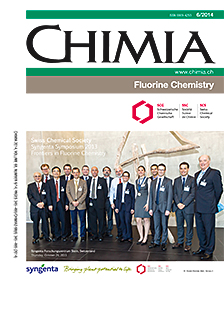Simple Vector Considerations to Assess the Polarity of Partially Fluorinated Alkyl and Alkoxy Groups
DOI:
https://doi.org/10.2533/chimia.2014.356Keywords:
Fluorinated alkoxy groups, Fluorinated alkyl groups, Lipophilicity, Polarity, Vector analysisAbstract
While H/F exchange at aryl groups or introduction of CF3 units have dominated medicinal chemistry for decades, the use of partially fluorinated alkyl and alkoxy groups has come into focus more recently. A simple bond vector analysis scheme, based on the assumption of context-independent bond polarities as well as idealized configurational and conformational geometries, is applied to small alkyl and alkoxy groups with prototypic fluorination patterns for qualitative assessments of relative polarities as well as polarity modulation by conformational change. Combined with a constant volume increase for each hydrogen/fluorine exchange these polarity estimates can be translated into expected lipophilicity shifts (?logP), using a simple parameterization scheme derived from experimental logP values. While terminal monofluoro- and gem-difluoromethyl groups in small aliphatic units are correctly predicted to show lower lipophilicity compared to their tri- or non-fluorinated congeners, vicinal difluoro and bis-vicinal trifluoro patterns are identified to exhibit significantly lower lipophilicities than their respective geminal di- and trifluoro substituted counterparts. The trifluoromethoxy group is diagnosed as an intrinsically lipophilic unit compared to the parent methoxy group. The difluoromethoxy group is of particular interest as it can easily interconvert between a highly lipophilic and a polar conformation, thus enabling this unit to adjust to polarity changes of the molecular environment. For di- and trifluoroalkoxy groups, again the vic-difluoro and bis-vic-trifluoro substitution patterns stand out as most promising to keep lipophilicity low. The 1,3-difluoro pattern next to an ether moiety shows an interesting conformational dependence of polarity, similar to the difluoromethoxy group. While very qualitative in nature, the simple bond vector analysis promises to be a useful tool for the identification of lipophilicity-lowering fluorinated alkyl or alkoxy groups and particularly those groups that display marked conformation-dependent lipophilicity and thus potentially serve as 'environmental adaptors'.Downloads
Published
2014-06-26
How to Cite
[1]
K. Müller, Chimia 2014, 68, 356, DOI: 10.2533/chimia.2014.356.
Issue
Section
Scientific Articles
License
Copyright (c) 2014 Swiss Chemical Society

This work is licensed under a Creative Commons Attribution-NonCommercial 4.0 International License.







